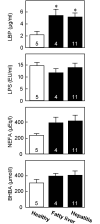Lipopolysaccharide-binding protein in follicular fluid is associated with the follicular inflammatory status and granulosa cell steroidogenesis in dairy cows
- PMID: 38644218
- PMCID: PMC11153122
- DOI: 10.1262/jrd.2023-104
Lipopolysaccharide-binding protein in follicular fluid is associated with the follicular inflammatory status and granulosa cell steroidogenesis in dairy cows
Abstract
Metabolic stress and subsequent hepatic dysfunction in high-producing dairy cows are associated with inflammatory diseases and declining fertility. Lipopolysaccharide (LPS)-binding protein (LBP) is produced by hepatocytes and controls the immune response, suggesting that it is involved in the pathophysiology of inflammation-related attenuation of reproductive functions during metabolic stress. This study investigated the effect of LBP on the inflammatory status, oocyte quality, and steroidogenesis in the follicular microenvironment of dairy cows. Using bovine ovaries obtained from a slaughterhouse, follicular fluid and granulosa cells were collected from large follicles to evaluate the follicular status of metabolism, inflammation, and steroidogenesis. Cumulus-oocyte complexes were aspirated from small follicles and subjected to in vitro embryo production. The results showed that follicular fluid LBP concentrations were significantly higher in cows with fatty livers and hepatitis than in those with healthy livers. Follicular fluid LBP and LPS concentrations were negatively correlated, whereas LPS concentration showed a positive correlation with the concentrations of non-esterified fatty acids (NEFA) and β-hydroxybutyric acid in follicular fluid. The blastulation rate of oocytes after in vitro fertilization was impaired in cows in which coexisting large follicles had high NEFA levels. Follicular fluid NEFA concentration was negatively correlated with granulosa cell expression of the estradiol (E2) synthesis-related gene (CYP19A1). Follicular fluid LBP concentration was positively correlated with follicular fluid E2 concentration and granulosa cell CYP19A1 expression. In conclusion, follicular fluid LBP may be associated with favorable conditions in the follicular microenvironment, including low LPS levels and high E2 production by granulosa cells.
Keywords: Dairy cows; Follicles; Lipopolysaccharide binding protein; Oocytes; Steroidogenesis.
Conflict of interest statement
None of the authors have financial or personal relationships that could inappropriately influence or bias the content of this paper.
Figures



Similar articles
-
Lipopolysaccharide in ovarian follicular fluid influences the steroid production in large follicles of dairy cows.Anim Reprod Sci. 2014 Jan 10;144(1-2):6-13. doi: 10.1016/j.anireprosci.2013.11.005. Epub 2013 Nov 22. Anim Reprod Sci. 2014. PMID: 24321186
-
Relationships between the antral follicle count, steroidogenesis, and secretion of follicle-stimulating hormone and anti-Müllerian hormone during follicular growth in cattle.Reprod Biol Endocrinol. 2019 Nov 5;17(1):88. doi: 10.1186/s12958-019-0534-3. Reprod Biol Endocrinol. 2019. PMID: 31690325 Free PMC article.
-
Mitochondrial Function in Modulating Human Granulosa Cell Steroidogenesis and Female Fertility.Int J Mol Sci. 2020 May 19;21(10):3592. doi: 10.3390/ijms21103592. Int J Mol Sci. 2020. PMID: 32438750 Free PMC article.
-
Non-esterified fatty acids in the ovary: friends or foes?Reprod Biol Endocrinol. 2020 Jun 6;18(1):60. doi: 10.1186/s12958-020-00617-9. Reprod Biol Endocrinol. 2020. PMID: 32505200 Free PMC article. Review.
-
Metabolic characteristics of follicular fluid in cows: A review.Anim Reprod Sci. 2025 Aug;279:107872. doi: 10.1016/j.anireprosci.2025.107872. Epub 2025 Jun 24. Anim Reprod Sci. 2025. PMID: 40580648 Review.
Cited by
-
Impact of obesity on proteomic profiles of follicular fluid-derived small extracellular vesicles: A comparison between PCOS and non-PCOS women.J Ovarian Res. 2025 Jun 4;18(1):121. doi: 10.1186/s13048-025-01703-5. J Ovarian Res. 2025. PMID: 40468347 Free PMC article.
References
-
- Syriou V, Papanikolaou D, Kozyraki A, Goulis DG. Cytokines and male infertility. Eur Cytokine Netw 2018; 29: 73–82. - PubMed
-
- Qian L, Li Q, Li H. Effect of hepatitis B virus infection on sperm quality and oxidative stress state of the semen of infertile males. Am J Reprod Immunol 2016; 76: 183–185. - PubMed
-
- Magata F, Tsukamura H, Matsuda F. The impact of inflammatory stress on hypothalamic kisspeptin neurons: Mechanisms underlying inflammation-associated infertility in humans and domestic animals. Peptides 2023; 162: 170958. - PubMed
-
- Sheldon IM, Noakes DE, Rycroft AN, Pfeiffer DU, Dobson H. Influence of uterine bacterial contamination after parturition on ovarian dominant follicle selection and follicle growth and function in cattle. Reproduction 2002; 123: 837–845. - PubMed
MeSH terms
Substances
LinkOut - more resources
Full Text Sources
Miscellaneous

